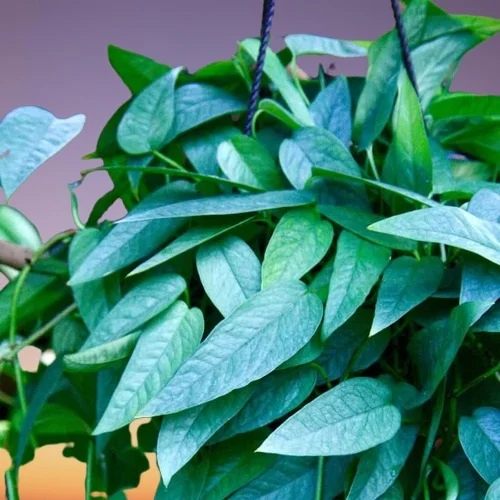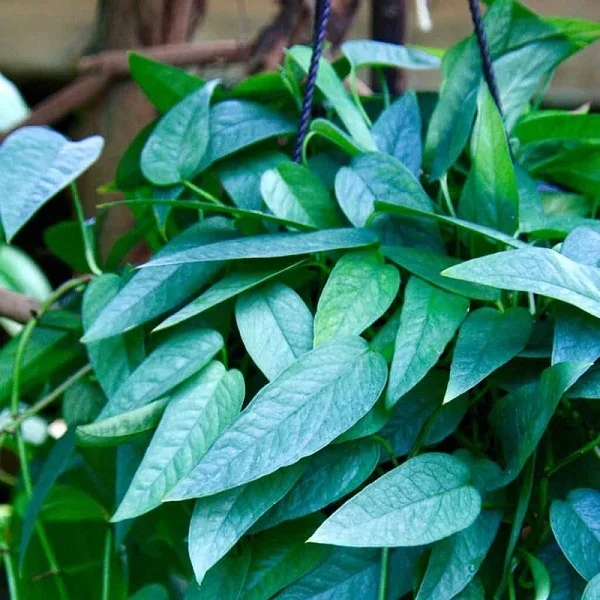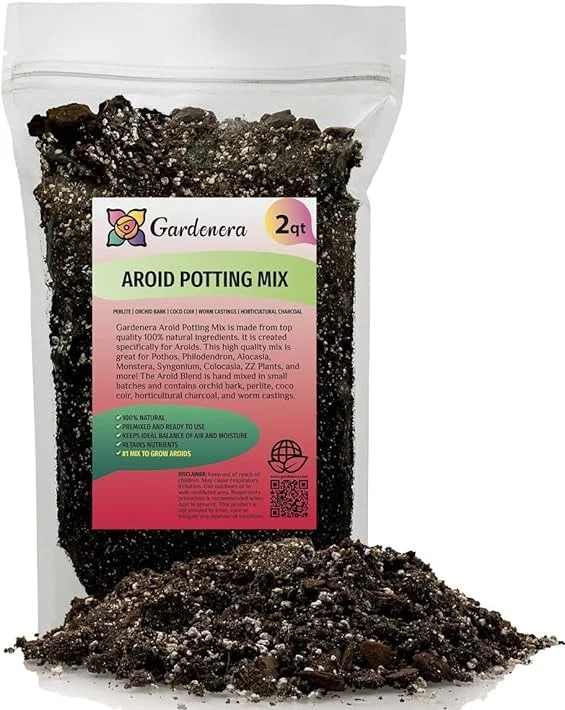Epipremnum pinnatum 'Cebu Blue' Indoor Care, Propagation, Common Problems & Remedies
Some links in this post may be affiliate links
Epipremnum pinnatum Cebu Blue Pothos grows best in medium to bright indirect light, warm and humid conditions, and moderately moist, fertile, well-drained soil coupled with monthly feeding in the growing season.
Epipremnum pinnatum 'Cebu Blue' is a low maintenance vine and among the popular Pothos plants on account of its spectacular lance-shaped leaves, and climbing and trailing growth habit.
The young leaves in Cebu Blue Pothos have an elongated shape with a pointed end and a smooth margin. As they mature, they grow larger, become fenestrated (have holes along the mid-rib) and lobed (have slits along the edges). The leaves have a silvery-blue-green, glaucous and textured appearance and can grow to about 6 inches long.
The plant has two growth habits. It can grow as a climber by means of aerial roots or as a creeper along the soil surface. To achieve fenestrations and the beautiful lobes, the plant should be grown vertically.
Cebu Blue Pothos can be grown in a hanging basket where the stems and leaves can cascade downwards beautifully or can be provided with a climbing structure like a moss pole or a trellis. They are among the best plants for a hanging basket, a desktop, a plant shelf or a pedestal.
Cebu Blue Pothos is often mistaken for Monstera siltepecana. The main difference being in their leaves. Those of Monstera siltepecana are larger, variegated with distinct dark-green veins while those of Cebu Blue are smaller and have a glaucous and textured appearance.

Botanical name: Epipremnum pinnatum 'Cebu Blue'
Family: Araceae
Common names: Cebu Blue Pothos
Origin
Epipremnum pinnatum 'Cebu Blue' is native to Cebu Island in Philippines where it grows as an epiphyte on trees.
Size
Cebu Blue Pothos can grow to a height of 30 feet in its natural habitat but indoors it will only grow to about 5-10 feet.
Is Cebu Blue Pothos toxic?
Yes. Cebu Blue Pothos like other species of the Araceae family is thought to be toxic to both humans and pets. Wikipedia indicates that the plants contain Calcium oxalate. If ingested it can cause burning and swelling in the mouth and throat, vomiting, diarrhea and abdominal pains. Keep it away from the reach of children and pets.
Related Plants
Epipremnum pinnatum is similar to;
1. Epipremnum pinnatum (Dragon Tail Pothos) whose leaves are elonagted, glossy with dark-green topsides and lighter undersides and become deeply lobed as the plant matures.
2. Epipremnum pinnatum 'Baltic Blue' whose leaves are elongated, smooth, bluish-green and have no sheen.
Where to Buy
Cebu Blue Pothos is a charming plant to add to your collection. You may acquire these plants online from Etsy (Link to Etsy).
How to Care for Cebu Blue Pothos Indoors
To care for Cebu Blue Pothos indoors, provide medium to bright indirect light, warmth of 15-280C, humidity of 60-70% and moderately moist, fertile, well-drained potting mix coupled with monthly feeding in spring and summer.
Epipremnum pinnatum 'Baltic Blue' requires to be repotted only when pot-bound. Regular pruning is necessary to keep the plant tidy as well as rejuvenate growth. Keep reading for more on these growing conditions and how to achieve them.

Watering
How often should I water Cebu Blue Pothos?
Water your Cebu Blue Pothos liberally in spring and summer until water comes out through the drainage holes while allowing the top 2-3 inches of soil to dry out between waterings. Keep the soil moderately moist and avoid overwatering to prevent rotting, yellowing and leaf drop.
Decrease watering in fall and winter to keep the soil slightly moist as growth is minimal at this time. Do not let the soil dry out completely to avoid wilting, yellowing and leaf loss.
Use room temperature water to prevent cold shock which can lead to stunted growth, yellowing and leaf fall. Only use water that is free of chlorine and other dissolved chemicals to prevent browning of leaf tips and edges.
Confirm that the pot has a drainage hole and the soil is well-draining to prevent waterlogging as it can lead to root-rot and loss of the plant.
Light Requirements
How much light does Cebu Blue Pothos need?
Cebu Blue Pothos needs medium to bright indirect light (filtered light). Keep it away from direct sunlight to prevent scorching of the leaves.
It can tolerate lower light but the growth will be much slower than in brighter conditions. Too little light will result in dull leaves and lack of fenestrations. Therefore, where the natural light is not adequate, you may instal full spectrum grow lights to increase it.
Regularly rotate the pot to ensure that the plant receives light on all sides for uniform growth and to prevent leggy growth.
Temperature & Humidity
Cebu Blue Pothos thrives in a warmth of 15-280C; a room temperature that is comfortable for you is ideal for the plant. Keep it away from drafts like Ac units, drafty windows and doors, hot air vents among others to prevent reduced growth, yellowing and leaf drop.
Cebu Blue Pothos prefers a humidity of 60-70%. If the air is too dry the plant will develop brown, shrivelled leaf tips and edges. To increase humidity, set the pot on a wet pebble tray, group the plants together or use a cool mist humidifier. Maintain good air flow to depress fungal diseases.
Fertilizer
Feed your Cebu Blue Pothos with a balanced, water-soluble fertilizer monthly in spring and summer for a lush growth. Do not feed in fall and winter as growth is reduced at this time and feeding at this time can result to fertilizer burn.
Occasionally leach out excess salts by running a stream of water through the soil until it drains through the drainage hole. Allow the water to run for 5-10 minutes to clear most of the salts.
Potting Medium
The best potting soil for Cebu Blue Pothos should be rich in organic matter and well-drained to prevent it from getting soggy while providing the required nutrients. Most Aroids soils and potting mixes designed for Pothos are good for this plant.
Repotting
Repot your Cebu Blue Pothos in the growing season only when pot-bound. Use a rich, free-draining soil and a pot one size larger than the current one. Ascertain that the pot has a drainage hole to prevent the soil from getting soggy as it can lead to root-rot. Take a look at these pots available on Amazon.
Pruning & Grooming
Pruning Cebu Blue Pothos involves frequent removal of any dead foliage to keep the plant neat and tidy and also minimize pest and disease infestations.
Cutback the stems at the beginning of the growing season when they become straggly to rejuvenate growth and also keep the plant compact. The foliage emanating from the pruning can be used to propagate new plants which you can share with friends and family.
Damp-wipe the leaves regularly with a soft cloth to get rid of dust and also discourage pest and disease infestations.
Cebu Blue Pothos Propagation
Cebu Blue Pothos is propagated from stem cuttings at the beginning of the growing season (spring and early summer). The cuttings can be rooted in soil or in water, however, those rooted in water take longer to root.
1. How to root Cebu Blue Pothos stem cuttings in soil
Cebu Blue Pothos propagation in soil:
- Take a 4-6 inches stem cutting from a healthy plant. Ensure the cutting has at least 4-6 leaves and some aerial roots.
- Strip off the lower leaves and insert the cutting in moist rooting soil, ensure at least one leaf node together with the aerial roots are covered under soil.
- To hasten rooting, cover the set up with clear polythene to create a greenhouse effect that is warm and humid conditions.
- Place the set up in a warm, well-lit place away from direct sunlight to prevent scorching.
- Maintain the soil moist through out until the roots develop which is indicated by new growth.
- The cuttings should root in about 2-3 weeks and the new plants will be ready to be transplanted into individual pots in about 2-3 months.
- When ready to transplant, fill 6-8 inches pots halfway with free-draining soil and lightly moisten the soil.
- Water the new plants deeply, carefully lift the new plants with a ball of soil around the roots and place in the center of the pots.
- Fill the pot while lightly firming the soil around the plant roots. Water the soil thoroughly until water comes out through the drainage hole.
- Position the pots under bright indirect light and begin normal routine care.
2. How to root Cebu Blue Pothos stem cuttings in water
Cebu Blue Pothos propagation in water:
- Take a 4-6 inches stem cutting from a healthy plant. Ensure the cutting has at least 4-6 leaves and some aerial roots.
- Strip off the lower leaf and place the cutting in a jar of plain water, ensure at least one leaf node is covered in water as well as the aerial roots.
- Position the set up in a warm, well-lit spot and change the water every 5-7 days.
- The cutting should root in about 3-4 weeks. When the roots are about 2 inches long, start acclimating them to grow in soil.
- Acclimating the roots to grow in soil entails adding a little soil daily into the rooting jar over a period of time until when there is more soil than water in the rooting jar.
- The new plant is ready for transplanting when the roots have grown to about 4 inches long.
- When the plants are ready to be transplanted, fill 6-8 inches pots halfway with free-draining soil and lightly moisten the soil.
- Carefully lift the new plants with a ball of soil around the roots and place in the center of the pots.
- Lightly firm the soil around the plant roots as you fill the pot. Water thoroughly until water comes out through the drainage holes.
- Place the pots in a spot where they can receive bright indirect light and begin normal routine care.

Cebu Blue Pothos Problems & Solutions
What are the common problems with Cebu Blue Pothos?
Cebu Blue Pothos common problems are yellow leaves, leaf drop, drooping leaves, brown tips & edges, leggy growth, pests among others. Keep reading for more details on these problems and their fixes.
Yellow leaves
Why are the leaves on my Cebu Blue Pothos turning yellow?
The main causes of yellow leaves on your Cebu Blue Pothos are insufficient light, soggy soil, inconsistent watering, drafts, nutrients deficiency or aging.
How to fix it
Insufficient light: Position the plant in medium to bright indirect light or use a grow light if you do not have adequate light in your home.
Soggy soil: Use a free-draining soil and a pot with a drainage hole.
Inconsistent watering: Water when the top 1-2 inches of soil feel dry but do not allow the soil to dry out completely. Do not water on schedule.
Drafts: Keep the plant away from sources of drafts like hot air vents, AC units, hot surfaces, windy doors among others.
Nutrients deficiency: Feed the plant with a balanced, water-soluble fertilizer every 4 weeks in spring and summer.
Aging: This is a natural process. As the plant matures the older leaves turn yellow and drop off.
Leaf drop
Leaf drop on Cebu Blue Pothos is caused by inconsistent watering, soggy soil, too little light, drafts or use of cold water.
How to fix it
Inconsistent watering: Water when the top 1-2 inches of soil dry out but never allow the soil ball to dry out completely.
Soggy soil: Use a pot with a drainage hole and well-draining soil.
Too little light: Position the plant in medium to bright indirect light or use a grow light if you do not have enough light in your home.
Drafts: Keep the plant away from sources of drafts like windy doors, drafty windows, AC units, heat sources, hot air vents among others.
Use of cold water: Use water that is at room temperature to prevent cold shock.
Drooping leaves
Drooping leaves on Cebu Blue Pothos are caused by improper watering, soggy soil, temperature stress, low humidity or salts buildup.
How to fix it
Incorrect watering: Water when the top 1-2 inches of soil dry out but never allow the soil to dry out completely.
Soggy soil: Ensure that the soil is well-draining and the pot has a drainage hole.
Temperature stress: Keep the plant away from sources of drafts like heat sources, stoves, AC units, windy doors among others.
Low humidity: Group the plants together or set the pot on a wet pebble tray to heighten humidity.
Salts buildup: Avoid too much fertilizer and do not feed in fall and winter. Flush out excess chemicals from the soil.
Brown leaf tips & edges
Brown leaf tips and edges on Cebu Blue Pothos are due to underwatering, soggy soil, dry air, or salts buildup.
How to fix it
Underwatering: Water the plant when the top 1-2 inches of soil dry out and never allow the soil to dry out completely for a prolonged period.
Soggy soil: Use well-draining soil and a pot with a drainage hole.
Dry air: To increase humidity, set the pot on a wet pebble tray, use a cool mist humidifier or group the plants together.
Salts buildup: Regularly get rid of accumulated salts by running a stream of water through the soil until it comes out through the drainage hole. Let it run for 5-10 minutes to remove most of the salts.
Leggy growth
Leggy growth accompanied by small pale leaves on Cebu Blue Pothos are caused by too little light and overwatering.
How to fix it
Too little light: Position the plant in a more brighter spot where it will receive medium to bright indirect light or instal grow lights if the natural light is inadequate.
Overwatering: Water only when the top 1-2 inches of soil dry out. Reduce watering to keep the soil slightly moist in fall and winter.
Pests
Common pests on Cebu Blue Pothos are spider mites, scale insects and mealybugs which are prevalent in dry air conditions.
How to fix it
- Isolate the affected plant to prevent spread to other plants.
- Treat the infested plant with neem oil or insecticidal soap. Ensure to follow the manufacturers' instructions.
- Regularly check underneath and between the leaves for these pests and carry out timely control measures.
- To minimize the pests infestations, group the plants together or set the pot on a wet pebble tray to raise humidity.
- Maintain good air flow to discourage the pests infestations.
You liked it? Share on social media.
Related Content
Amazon Associates Disclosure
Homeplantsguide.com is a participant in the Amazon Services LLC Associates Program, an affiliate advertising program designed to provide a means for sites to earn advertising fees by advertising and linking to amazon.com.





